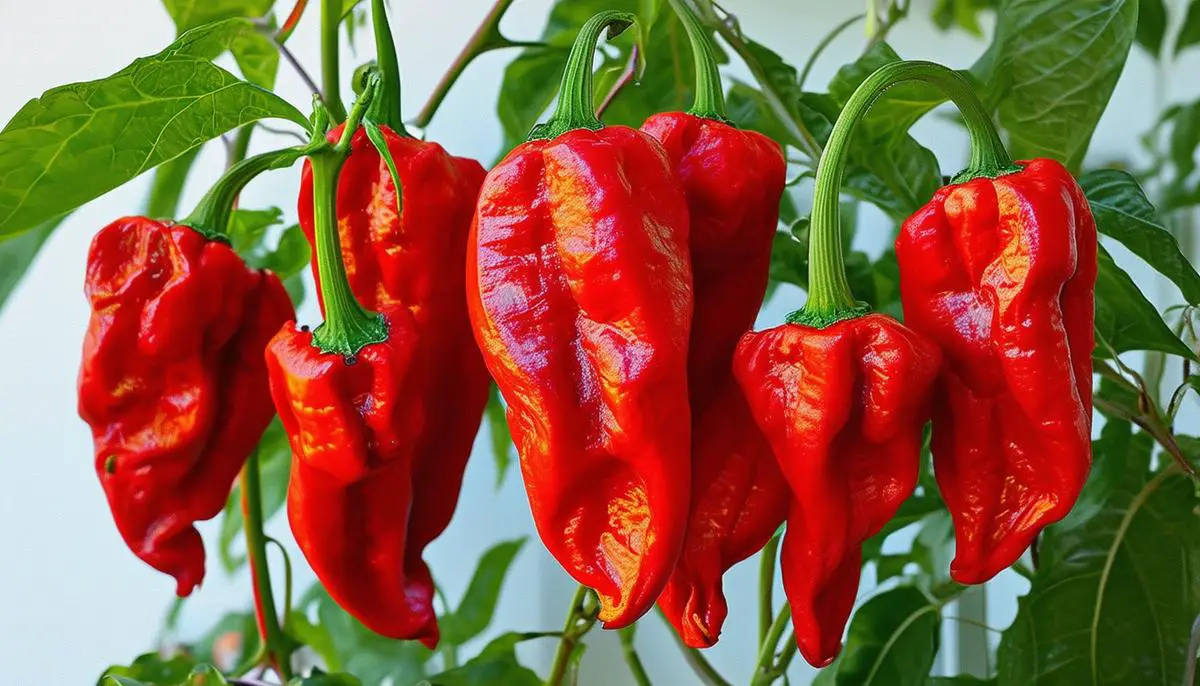
Origins and History
Bhut Jolokia, famously known as the Ghost Pepper, originates from the northeastern regions of India, specifically Assam. This fiery chili is not just a culinary ingredient but a profound part of the cultural heritage in Assam and surrounding areas. Its naming is a tale of translation and misunderstanding: “Bhut” in Assamese loosely translates to “ghost” in English, contributing to its spicy reputation.
Interestingly, Bhut Jolokia serves purposes beyond the kitchen. Historically, locals have used these peppers to fend off wild elephants from their habitats and crop fields—an intelligent use of natural resources for protection.1 This use symbolizes the chili’s intense potency, where its application transcends culinary boundaries.
Culturally, Bhut Jolokia peppers are woven into daily life and festivity. In local cuisines, it adds character and depth to dishes, forming a robust and fiery identity. This pepper rises beyond an ingredient to a catalyst of communal experiences, shared around stories and culinary experiments.
Modern cultivation practices continue to propel its popularity globally. From local bazaars in Assam to international markets, the Ghost Pepper’s influence skyrocketed after its recognition as one of the world’s hottest chilies in 2007 by the Guinness Book of World Records.2 This acknowledgment sparked global curiosity, ushering in an era of viral internet challenges and international culinary inclusion.
Locals also cherish this pepper for its medicinal properties. Traditional use in natural remedies demonstrates a holistic approach to health, treating ailments from stomach issues to arthritis – a testament to the community’s resourcefulness.
The Ghost Pepper has adapted to the global digitized dialog through its intense online presence. From culinary innovations incorporating Bhut Jolokia in fusion recipes to daring its consumption as part of social media challenges, its essence embodies both historical reverence and modern recreation.
This journey from the fields of Assam to being a global sensation encapsulates more than just agricultural success; it charts the course of an unassuming pepper as it flavors the complex dish of global interaction.
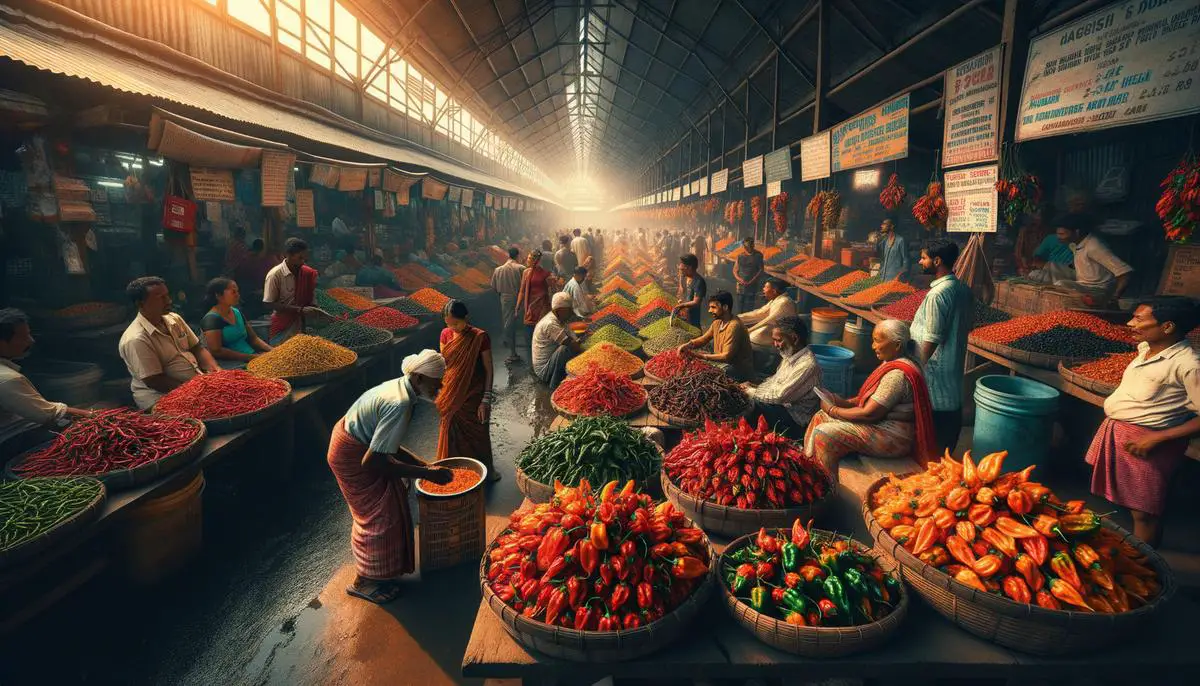
Cultivation Practices
The cultivation of Naga Jolokia, or Ghost Pepper, requires specific climatic conditions and meticulous agricultural practices to nurture this fiery chili. Thriving in a subtropical climate, Naga Jolokia peppers favor the warm and humid conditions of its native Assam. The ideal growing temperature ranges between 70°F (21°C) and 90°F (32°C).
Soil preparation is crucial for raising Ghost Peppers. It requires fertile, well-drained soil with a pH level ranging from 5.5 to 6.8, allowing for optimal nutrient uptake. Before planting, farmers typically mix organic compost or manure into the soil to enhance its fertility and water-holding capacity. Watering should be consistent but moderate to maintain the chilies’ heat level and avoid root diseases.
The seeds of Bhut Jolokia need a warm bed for germination, with an initial soil temperature of at least 70°F. After germination, seedlings are typically grown under controlled conditions to protect them from excessive natural elements until they are sturdy enough for plantation.
As the plants mature, farmers need to be astute in their nurturing practices. Pruning is essential to encourage more fruitful branching, which affects the yield and quality of the chilies. Adjusting plant nutrients during the growth phases is also pivotal. An increase in potassium helps during fruit development, enhancing their quality and heat profile.
Harvesting Ghost Peppers is a fiery task. These peppers transition from green to a vivid red, signifying their peak heat and readiness for harvest. Farmers don hand gloves as a barrier against the burning oils and harvest with caution, often using tools to cut the stem without damaging the plant.
Ghost Peppers have garnered a niche globally, seeing sustained demand. Growers perpetually juggle between market trends and traditional growing knowledge to optimize their yields and heat—a dance of nature and commerce co-existing resiliently. Such specialized care from seeding to harvest sets the cultivation of Naga Jolokia apart, embodying an launching of flavor and a testament to the growers’ dedication.
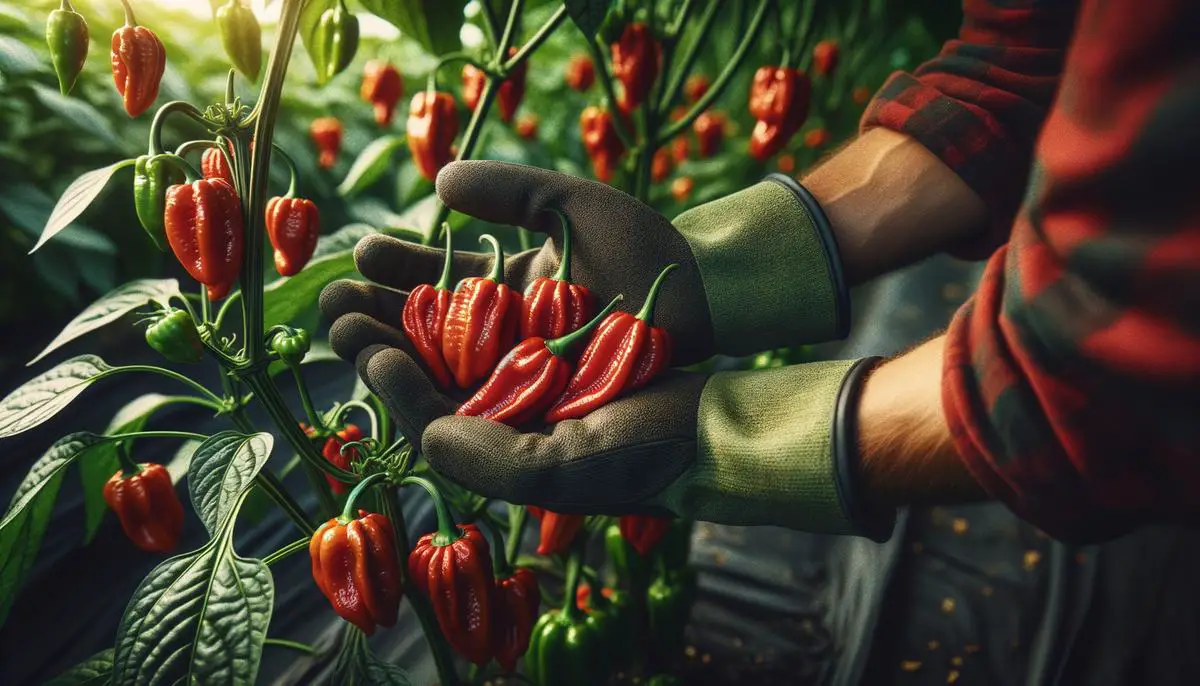
Heat and Flavor Profile
Among the pantheon of notorious chili peppers revered for their scorching heat, Naga Jolokia holds its title with fiery prowess. The source of its extreme piquancy is capsaicin, a potent chemical concentrated within the pepper’s placental tissue. This chemical interacts with sensory receptors, tricking our brains into perceiving intense heat where there is no actual heat.
When measured on the Scoville scale—a standard for assessing the ‘hotness’ of chili peppers—the Naga Jolokia boasts ratings often well over 1,000,000 Scoville Heat Units (SHUs).3 To put that in context, it’s about 400 times hotter than a typical jalapeño. This formidable score allows the Ghost Pepper to surpass many of its fiery counterparts, holding its ground even against other superhots.
The flavor profile of the Naga Jolokia is unique and complex amidst its sheer heat. Initially, one might notice a fruity, somewhat sweet taste, akin to an apricot’s sweet nectar, which covertly ushers in the subsequent wave of intense, palate-engulfing spice. This slow-building heat crescendo is deceptive; it lures the daring gourmet into a false sense of security before the full intensity of its fire makes itself known.
This element of delayed yet explosive heat makes Naga Jolokia a thrilling yet challenging ingredient in the culinary world. In northeastern Indian cuisine where this pepper originates, it adds a depth to dishes that is irreplaceable, creating layers of flavor that enmesh with other local ingredients. Western cuisines have cautiously approached the Ghost Pepper, incorporating small amounts into sauces, marinades, and even chocolates and candies.
Experimentation is key, as incorporating Naga Jolokia into dishes requires finesse and respect for its heat. In unwary kitchens, the unmitigated use of this chili can overpower any other flavor, turning meals into fiery experiences that challenge the limits of spice tolerance rather than culinary exploration. Understanding and harnessing its flavor profile enables chefs to transform meals into complex, intensely satisfying experiences.
Behind every use of the Naga Jolokia lies an understanding of both science and art—balancing its chemical fire with its gastronomic value, making it a cherished ingredient among culinary adventurers seeking to push the boundaries of flavor and heat.
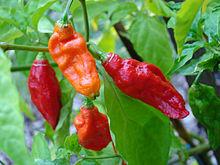
Health Implications and Safe Handling
Capsaicin, the volatile chemical contributing to the powerhouse heat of Naga Jolokia, holds significant potential in various health benefits, having been utilized in both traditional and modern medicine. It’s known for its analgesic properties, offering relief in pain management treatments through topical creams for conditions such as arthritis and neuropathy.4 By activating and then desensitizing the neuronal pathways that relay pain signals, capsaicin can temporarily halt the agony and provide periods of soothing relief.
Research has explored capsaicin’s role in boosting metabolism, potentially aiding in weight loss efforts by increasing energy expenditure and reducing appetite.5 Some studies suggest that capsaicin might even have anti-inflammatory and gastroprotective properties, helping to reduce inflammation and protect the gastric mucosa. This could be pivotal for chronic inflammation sufferers, leading to more holistic wellness approaches.
However, capsaicin’s potent nature demands respect and awareness concerning its physiological effects. When not handled appropriately, exposure to capsaicin can lead to uncomfortable or harmful reactions. Skin contact can cause dermatitis-like symptoms, while inhalation might inflame the respiratory pathways. Consuming high quantities can trigger gastric distress or exacerbate conditions like irritable bowel syndrome. These responses underscore the necessity for cautious engagement with this powerful component.
To safely navigate the fiery challenge and health potential of Ghost Peppers, proper handling techniques are essential:
- Gloves Are a Must: Always wear nitrile or latex gloves when handling raw Naga Jolokia peppers to prevent the capsaicin from contacting the skin.
- Protective Eyewear: When cutting or dicing these peppers, it’s prudent to wear goggles. Capsaicin can vaporize slightly when exposed to air, and a slight rub of the eyes with contaminated fingers can lead to intense pain and temporary visual impairment.
- Adequate Ventilation: Make sure your kitchen is well-ventilated; if available, turn on overhead exhaust fans. Breaking the pepper’s skin releases capsaicin into the air, which can irritate the mucous membranes.
- Gentle Washing: After handling, wash hands and surfaces diligently with soapy water to remove any residues. Water alone will not wash away the oily capsaicin.
- Gradual Introduction in Dishes: When cooking with Naga Jolokia, start with small amounts. A micro-dose can intensely flavor a large batch without overwhelming it. This controlled approach aids in harnessing the pepper’s power without letting it eclipse the primary flavors of your dish.
Embracing these safety measures illuminates an avenue to relish the heat thoughtfully rather than merely survive it. The integration of such practices ensures that each spicy endeavor with Naga Jolokia transforms from mere cooking to an orchestration of culinary artistry and safety. It is within this balance that chefs and enthusiasts alike discover the exhilarating potential of one of nature’s fiercest foods.
Global Influence and Culinary Uses
From its roots in Northeast India, the Ghost Pepper has traced a fiery trail through worldwide kitchen cultures. In the United States, Naga Jolokia has manifested into hot sauces and barbecue rubs, elevating smoky pork ribs and brisket. European chefs have incorporated this spice into elegant offerings, such as creamy risottos, pasta dishes, and luxe chocolates, offering a harmonious fusion of intense cocoa and piercing heat.
Asian cuisines take on Naga Jolokia with fervor. Thailand’s street-food cooks imbue traditional dishes like Tom Yum and Pad Thai with slivers of this incendiary chili, creating bursts of heat that propel these familiar dishes into thrill rides of flavor. In India, Naga Jolokia plays a role in pickle making, amplifying the umami in ordinary meals and turning rice and dal into culinary adventures.
As Naga Jolokia imprints itself upon the international culinary landscape, each new adaptation speaks to its unrivaled piquancy and the cultural exchange it stimulates. This pepper infuses histories into every dish it graces, making it a cherished protagonist in the global kitchen saga.
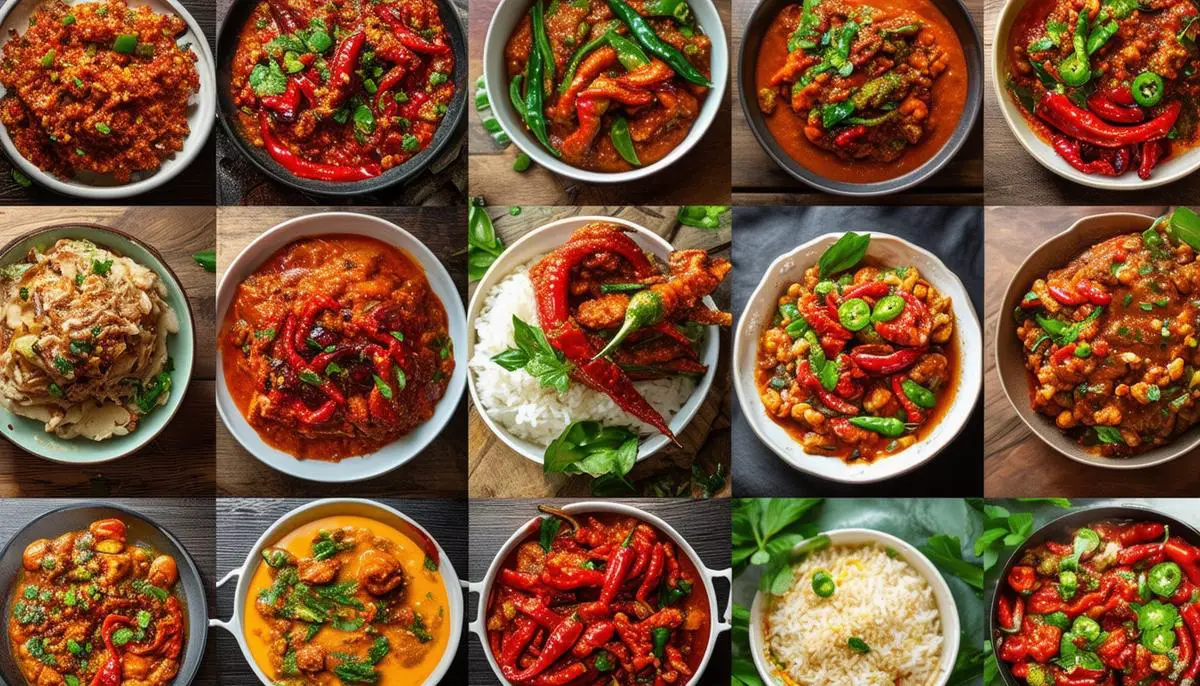
Conservation and Future Prospects
As the demand for Naga Jolokia grows, concerns pivot toward its conservation and sustained agronomic future. Genetic diversification and preservation strategies are becoming crucial to maintain resilience against pests, diseases, and climatic stressors.
Agricultural scientists and horticulturists have stirred efforts to conserve and study the Naga Jolokia’s diverse genetic strains through seed banks and germplasm collections. Biotechnological advancements, such as tissue culture techniques and genome sequencing, contribute to creating resilient chili crop varieties without diluting the pepper’s notorious fiery traits1.
The cosmetic and pharmaceutical industries are exploring the potential of capsaicin, derived from Naga Jolokia, for its anti-inflammatory and antibacterial properties2. New cultivation methods, such as aeroponics, show promise in producing higher yield and quality, potentially allowing for Naga Jolokia cultivation beyond its native geography.
In the culinary sphere, chefs employ the Ghost Pepper in creating innovative dishes that challenge both the chef’s ingenuity and the diner’s audacity. Beyond traditional uses, modern kitchens view it as a tool for sensory innovation, impacting smell, taste, and even the kinesthetic sense of eating.
These facets of development mark a vivid trajectory into expanding uses and markets. Efforts tethered with conservation seek to harness the potential of Naga Jolokia and ensure its legacy and proliferation in both fields and markets—a cherished heredity as fiery as its taste, peppered across diverse arenas.
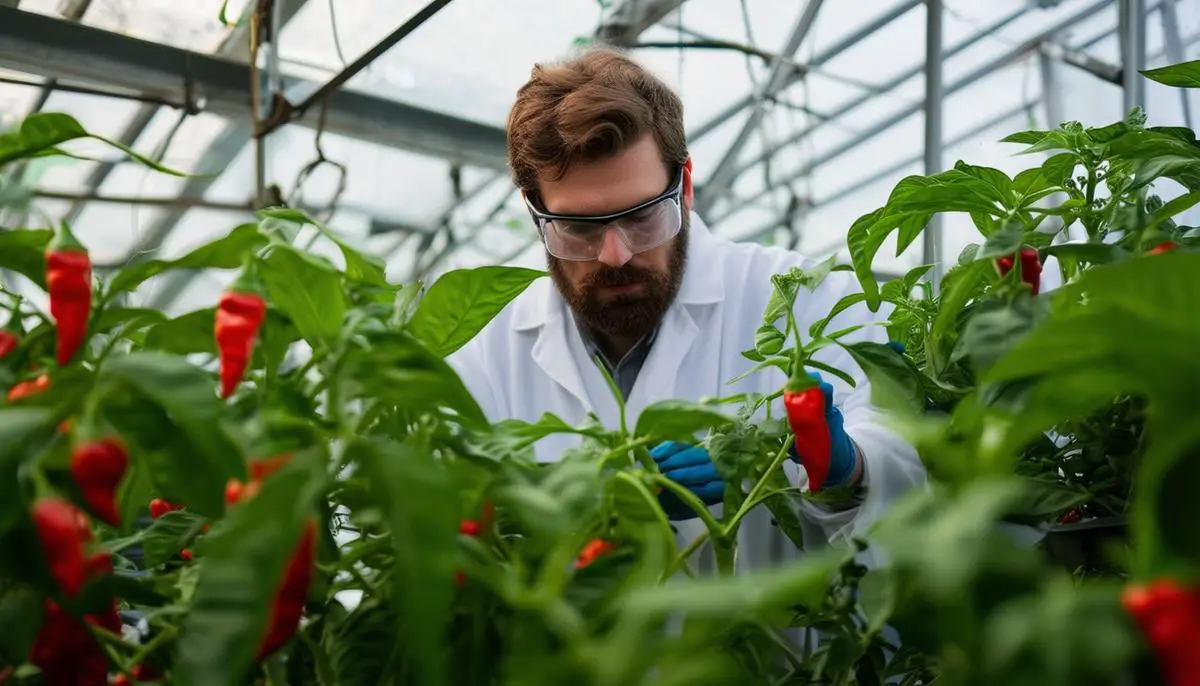
The Ghost Pepper is more than a measure of heat; it’s a testament to cultural exchange and culinary bravery. As it continues to ignite taste buds around the world, its story remains a vibrant reminder of how a single ingredient can influence global cuisine.



